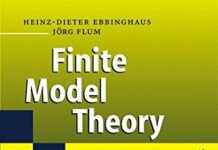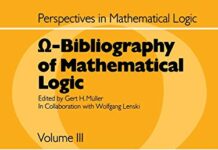
Ebook Info
- Published: 1990
- Number of pages: 416 pages
- Format: PDF
- File Size: 9.60 MB
- Authors: Heinz-Dieter Ebbinghaus
Description
This book is about all kinds of numbers, from rationals to octonians, reals to infinitesimals. It is a story about a major thread of mathematics over thousands of years, and it answers everything from why Hamilton was obsessed with quaternions to what the prospect was for quaternionic analysis in the 19th century. It glimpses the mystery surrounding imaginary numbers in the 17th century and views some major developments of the 20th century.
User’s Reviews
Reviews from Amazon users which were colected at the time this book was published on the website:
⭐This book is the best introduction to the basics of numbers (including all aspects) I know. Every chapter is composed with the same systematics. First a historical introduction is given describing which persons, when, and under which circumstances and ideas have discovered the respective number system. Then the mathematical definition of the number system is given followed by theorems (all of them being proved) and examples. This way one can better understand how the train of thoughts in number theory proceeded without loosing any mathematical accuracy in the presentation. Additionally it is the only book that covers in the same rigorous manner the whole field from the natural numbers to octonions.The book consists of 14 chapters; the 14-th chapter is about set theory (the basic of all mathematics) and can be read (as suggested by the authors) as the beginning chapter if one wishes to set the mathematical foundation before beginning with the number systems. If, however, one wishes to start in the order number theory developed during history one should begin with chapter 1 and then proceed in the given order.The first chapter defines the natural numbers using Peano axioms, integers and rational numbers. The real numbers follow in the second chapter; here all three possible definitions of the real numbers are given: Dedekind cuts, fundamental sequences and nesting of intervals. In the third chapter the complex numbers are presented in all their representations. The forth chapter formulates the fundamental theorem of algebra based on the complex numbers. The fifth chapter is devoted to the number pi whereas the sixth chapter describes the p-adic numbers where the prime numbers play a crucial role.In the seventh chapter the hypercomplex numbers are being introduced. It begins with William Rowan Hamilton’s quaternions as the first generalization of the complex numbers, describes all their representation and the anti-commutativity by the use of the commutator. The eigth chapter presents isomorphism theorems. The ninth chapter further generalizes the quaternions to octonions, defines the CAYLEY duplication process and underlines the anti-associativity of the octonions with the help of the associator. The tenth chapter presents composition algebras where the four division algebras (reals, complexes, quaternions, octonions) play a role. The amazing fact that only 4 division algebras exist is proved topologically in chapter eleven.The last chapters are devoted to nonstandard numbers (chapter twelve) and CONWAY’s definition of numbers via games (chapter thirteen). Chapter fourteen concludes (if not read as introduction) with set theory.
⭐Part A is crammed with information on the real and complex numbers and the fundamental theorem of algebra with much historical background. There are also two odd chapters with all sorts of information on pi and on p-adic numbers (which has nothing to do with anything else in the book). In part B the authors free themselves from the constraints of classical number systems and study more or less number-like algebras. In particular, the privileged role of R,C,H,O is linked to the existence n-square identities and the possible dimensions of division algebras. Part C treats some selected foundational topics: non-standard analysis, Conway’s “games” approach to the reals, set theory.One may wish that this book was “a lively story about one thread of mathematics–the concept of ‘number’– … organized into a historical narrative that leads the reader from ancient Egypt to the late twentieth century” (English edition editor’s preface). But this is hardly the case. I suppose it takes the combined efforts of eight authors to produce such a garbled and disorganised account, with so many dead-end side tracks, of a topic with such extraordinary inherent continuity, both historical and logical. Also, as in so many other modern books, the authors are primarily interested in algebra and foundations, and their perception of history is tilted accordingly. Their fear of getting their hands dirty with classical analysis means that they can only mention, not prove, the transcendence of pi, for instance.
⭐This apart from a small stamp on the edge of the page, this book is as if new. A wonderful reading for both naive and advanced readers that both provides mathematical insights and historical story-telling.
⭐なか見❕検索⤵で目次を見ると内容はおおよそわかるのですが、パートAは、自然数、整数、有理数、実数、複素数、代数学の基本定理、円周率πの超越性、p進整数など、何となく知っている話です。巻末に、有名な数学者の肖像として、オイラー、ガウス、ハミルトン、デデキント、カントール、フロベニウス、ホップ、ロビンソン(Abraham ROBINSON、知らない人でした)の8人の似顔絵が載っています。GTMのReadings in Mathematicsというシリーズの1冊で、裏表紙には、テクニックよりもその分野を見通して眺めることが主な目的で、この本に書いてあるのは17世紀から20世紀へ続く数学の大きな流れの一つだということです。パートBは、実多元体?(real division algebra)とかの話で、「実数体R上のベクトル空間で、積が定義されていて分配法則が成り立つもの」が「real algebra」(例:3次元空間とベクトル積)で、「空でないalgebraで、ax=bとya=bという方程式が解けるもの」が「division algebra」である(らしい)、それから4元数、8元数、フロベニウスの定理、ホップの定理、フルヴィッツの定理と続き、出てくる式や記号の多くは代数学の本で見たことが一応あるのですが、知らない話っていうのは数式を頼りに英文を読むということができないので、ぱらぱら見て楽しむのは無理でした。パートCは「ゲーム」と「集合」で、ゲームは、ニムとドミノを足すとか引くとか?集合は普通の集合です。数論を勉強したい人におすすめ…かどうか実はよくわかりません。GTMを書棚に並べたい人にはおすすめです、はい :-p
⭐Not found.
⭐Not found.
Keywords
Free Download Numbers (Graduate Texts in Mathematics, 123) in PDF format
Numbers (Graduate Texts in Mathematics, 123) PDF Free Download
Download Numbers (Graduate Texts in Mathematics, 123) 1990 PDF Free
Numbers (Graduate Texts in Mathematics, 123) 1990 PDF Free Download
Download Numbers (Graduate Texts in Mathematics, 123) PDF
Free Download Ebook Numbers (Graduate Texts in Mathematics, 123)


